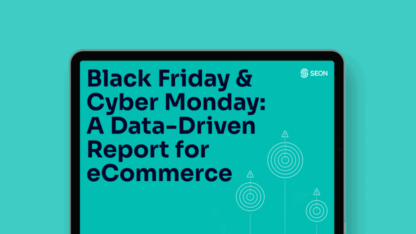As the eCommerce market expands, so does the threat of return fraud, a growing challenge for retailers navigating competitive online and in-store environments. In 2024, fraudulent returns accounted for 15.14% of all retail returns, costing businesses more than $103 billion. Beyond financial losses, return fraud erodes customer trust and damages brand reputation, making return fraud detection and prevention essential for sustainable retail growth.
What Is Return Fraud?
Return fraud occurs when individuals exploit a retailer’s return policy for personal gain. While return policies are intended to enhance customer satisfaction, fraudsters manipulate them to secure free products, cash or store credits.
A common type of return fraud is friendly fraud, in which shoppers buy products, use them briefly and then return them. Although both online and physical stores face these risks, eCommerce businesses are particularly vulnerable because they cannot physically verify goods at the point of return.
Return Fraud vs. Refund Fraud
Return fraud and refund fraud both involve manipulating retail processes to gain financial benefits. ThIt’s important to distinguish between return fraud and refund fraud, two related but different threats. Both involve manipulating retail processes to gain financial benefits, and they often occur in similar contexts — retail environments where return policies are designed to enhance customer satisfaction.
Return fraud involves the physical return of merchandise under pretenses. Examples include returning used or damaged goods, using fake receipts or returning stolen items.
Refund fraud occurs when a customer manipulates the refund process without returning the item. Tactics include false claims of non-delivery, reporting items as defective when they are not or requesting refunds for purchases never made.
By understanding these differences, retailers can build stronger strategies for both return fraud prevention and refund fraud detection.
Understand the six most frequent fraud tactics in online retail and learn how businesses can recognize and mitigate these risks.
Learn more
What Are the Consequences of Return Fraud?
Return fraud poses significant challenges for online retailers, creating ripple effects across revenue, operations, and customer trust. Meanwhile, fraudsters often walk away with little to no consequences, which fuels the cycle. The impact varies depending on the party involved.
Retailer Consequences of Return Fraud
Retailers bear the brunt of return fraud, with billions in collective annual losses. Beyond the immediate financial hit from fraudulent refunds, the hidden costs are just as damaging:
- Operational strain: Staff must spend time inspecting returned goods, processing refunds and managing disputes, diverting resources away from legitimate sales and customer service.
- Logistics costs: Shipping, restocking and reverse logistics fees add up quickly, especially when the merchandise cannot be resold in new condition. Electronics, apparel and cosmetics are particularly vulnerable categories.
- Inventory distortion: Fraudulent returns skew inventory data, making forecasting demand and maintaining stock accuracy harder. This often leads to over-ordering or understocking, which impacts supply chains.
- Policy trade-offs: Tightening return policies can help reduce fraud, but risks alienating genuine customers. A stricter stance may result in lower conversion rates, negative reviews or lost loyalty to competitors with more lenient policies.
- Reputation risks: High-profile cases of refund abuse or public disputes can damage brand perception, especially if legitimate customers feel unfairly penalized.
Many retailers ultimately accept return fraud detection as an unavoidable cost of doing business, though the long-term effects on profitability and growth can be significant.
What Happens to Fraudsters Who Commit Return Fraud
Compared to retailers, return fraudsters face minimal risks. Proving fraudulent intent is difficult without extensive evidence, and prosecution is rare unless crimes occur on a large, organized scale. Common outcomes include:
- Account bans: Offenders may be blocked from future purchases, but many create new accounts with different credentials to continue the cycle.
- Low legal risk: In most cases, retailers absorb losses rather than pursue costly litigation. Fines, restitution or jail time are unusual outside organized retail crime (ORC) cases.
- Exploiting gaps: Fraudsters often share tips on forums and exploit lenient refund processes across multiple retailers, amplifying the damage.
The imbalance — high cost for businesses, low risk for criminals — makes return fraud particularly persistent.
Impact of Return Fraud on Consumers and Cardholders
When stolen payment credentials are involved, cardholders may suffer collateral damage:
- Chargeback protection: Most victims recover funds through the bank’s dispute process, but this doesn’t eliminate the stress or potential cash-flow issues while waiting for reimbursement.
- Overdrafts and fees: Fraudulent charges may temporarily push accounts into overdraft, triggering penalties and late fees before the bank resolves the claim.
- Reputational impact: In some cases, victims may need to replace cards, reset linked accounts and rebuild trust with service providers.
- Identity theft risk: Stolen card details used in return fraud and refund fraud schemes can indicate larger identity theft issues, leaving consumers vulnerable to future fraud attempts.
While financial institutions usually shield consumers from long-term losses, the disruption and anxiety caused by these schemes should not be underestimated.
8 Types of Return Fraud
Return fraud exists on a broad spectrum, ranging from honest shopper mistakes to malicious operations on a large scale by organized crime rings. Here are some of its common forms:
1. Wardrobing (Free Renting)
This occurs when shoppers purchase items (often clothing, electronics or accessories) to use them once before returning. For example, someone might buy an outfit for a special event or a gadget for a short-term need, only to return it after use. While consumers may perceive this as harmless, retailers face losses because the returned items often can’t be resold at full price.
Detection tip: Tracking repeat returners and flagging persistent returns of “event-driven” products helps identify potential wardrobing.
2. Opportunistic Returns
Not all return fraud is premeditated. Some customers buy items, change their minds or find them cheaper elsewhere, then return them under questionable claims such as “delayed shipping” or “wrong size.” While these may blur the line between honest behavior and abuse, the cumulative effect costs retailers millions.
Prevention tip: Clearer return policies and digital footprint analysis help distinguish genuine shoppers from opportunistic abusers.
3. Seller Sabotage
Competitors sometimes weaponize returns by bulk-purchasing from rivals, then sending items back at the last moment. This strategy drains stock, disrupts inventory and inflates operational costs, directly harming the competitor’s business.
Detection tip: Monitoring bulk or high-frequency purchases from unusual accounts can expose sabotage attempts.
4. Bricking
Bricking is a particularly damaging form of return fraud. Fraudsters strip electronic items of valuable parts and return the hollowed product for a full refund. Retailers lose inventory value and risk reputational damage if the resold item later malfunctions.
Prevention tip: Implement return checks, such as weighing electronics or inspecting serial numbers, before issuing refunds.
5. Empty Box Fraud (Double-Dipping)
Fraudsters claim they received an empty package or missing items, demanding a refund or replacement. Sometimes, they return a box filled with unrelated materials to mimic weight. This practice, also called refund fraud, has surged alongside the growth of home delivery.
Detection tip: Using package scanning technology and maintaining photographic evidence during shipping can counter false empty-box claims.
6. Stolen Merchandise Returns
Here, fraudsters purchase goods using stolen credit cards, then return them in-store for cash or store credit. This tactic allows criminals to “launder” stolen goods into legitimate refunds, creating return fraud and identity theft risks.
Prevention tip: Requiring ID verification for returns and cross-referencing payment methods reduces exposure to this scheme.
7. Cross-Retailer Returns (Price Arbitrage)
Fraudsters exploit price differences by buying an item from one store at a lower cost and returning it to another retailer that sells it at a higher price. The result is a fraudulent profit at the retailer’s expense, with weaker refund fraud detection systems.
Prevention tip: Enforcing strict receipt and SKU checks makes returning items from outside sources harder.
8. Price Switching
In this scheme, criminals swap price tags or labels on products, purchasing them at a reduced rate and later returning them under the guise of higher-priced goods. This tactic is common in stores with self-checkout or less vigilant staff.
Detection tip: Train staff to inspect returns carefully and use barcode scanning technology to help stop price-switching attempts.
Protect your business from return fraud with digital footprint analysis while ensuring seamless customer onboarding.
Learn more
Best Practices to Prevent Return Fraud
Once return fraud occurs, options are limited. At best, retailers can report offenders to marketplaces, delivery services or law enforcement, but confrontation rarely pays off — especially against professional fraudsters. This makes proactive return fraud prevention essential.
Marketplaces like eBay offer some protection by allowing sellers to block suspicious buyers based on unpaid strikes, negative feedback or high-risk locations. Amazon provides fewer safeguards, often leaving merchants to rely on their own fraud detection or manual reviews of return data. By the time patterns emerge, however, losses may already be significant.
To mitigate risks before fraud escalates, retailers should implement these core best practices:
Require ID and contact for returns
Instead of relying solely on receipts, retailers should request buyer identification and contact details for all returns, particularly online purchases. This step allows businesses to cross-reference return requests with original orders, making refund fraud detection easier.
Maintaining notes from your risk or fraud prevention team at the point of return can reduce exposure. For instance, flagged accounts can be marked for secondary checks, ensuring items purchased with stolen credit cards are not refunded.
Eliminate cash refunds and offer credit or gift receipts
Cash refunds create incentives for fraudsters, especially those attempting to launder stolen goods. Instead, retailers can issue store credits, gift receipts or digital vouchers. Genuine customers still benefit from an opportunity to repurchase, but criminals lose the quick-cash incentive that drives many return fraud schemes.
Update your return policies
Consumer protection laws set specific baselines, but retailers can still strengthen their return policies to reduce fraud exposure. Examples include:
- Weighing returned electronics to ensure they match the original weight discourages bricking fraud.
- Limiting the return window for high-risk categories like fashion, luxury items and consumer electronics.
- Tracking repeat returners with unusually high volumes to identify potential abuse.
Clear policies deter fraudsters while telling customers that the business takes fraud seriously.
Analyze your buyers’ digital footprint
Fraudsters leave behind digital traces that reveal suspicious activity. Businesses can flag high-risk accounts by analyzing IP addresses, device fingerprints, geolocation mismatches, and social media presence before approving refunds.
Once reserved for enterprise retailers, digital footprint analysis is now cost-effective and accessible, making it one of the most potent tools for return fraud detection across both large and small merchants.
Return Fraud Detection Strategies
As businesses scale, return fraud becomes more complex and challenging to spot with manual methods alone. Investing in technology-driven detection systems ensures fraudsters are caught in real time. Effective strategies include:
- Machine Learning and Behavioral Analytics: Machine learning models can process millions of transactions to uncover anomalies invisible to human reviewers. For example, they might flag a shopper who consistently returns high-value goods across multiple accounts. These models adapt over time, improving accuracy as new fraud tactics emerge.
- Digital Footprint Analysis: This method examines online behaviors — such as device usage, login patterns and mismatched geolocation data — to identify accounts with a high likelihood of committing fraud. A lack of digital presence (e.g., no social profiles or unrealistic browsing patterns) can be an immediate red flag for return fraud detection systems.
- Historical Data Analysis: Retailers can identify repeat offenders by studying past returns and developing fraud risk profiles. For instance, if historical analysis reveals a cluster of refund fraud claims tied to a single region or payment method, businesses can adjust rules to prevent further abuse.
These detection techniques build layered defenses that protect inventory, brand reputation, and profit margins.
How SEON Helps Detect and Prevent Return Fraud
Balancing customer satisfaction with fraud prevention is one of the most complex challenges in retail. Overly strict policies drive legitimate customers away, while lenient ones encourage abuse. SEON addresses this challenge with integrated solutions automating return fraud detection and refund fraud prevention.
- Real-Time Digital Footprint Analysis: SEON evaluates data such as device information, IP addresses and online presence to distinguish between genuine shoppers and fraudsters quickly. SEON offers 900+ first-party, real-time data signals that go deeper and further than any other provider
- Real-Time Transaction Monitoring: Suspicious refund requests, such as multiple accounts tied to the same payment credentials, are flagged instantly.
- Customizable Fraud Rules: With SEON, tailor strategies to your business with any type of analysis and no limits on rules, with 240+ pre-defined rules offered. Retailers can customize SEON’s fraud detection system to match their specific return policies, ensuring that prevention doesn’t compromise customer experience.
By combining these capabilities, SEON empowers retailers to proactively reduce fraud, preserve customer trust and focus on growth. Instead of treating return fraud as a “cost of doing business,” companies can turn prevention into a competitive advantage.
SEON’s anti-fraud tools are designed to detect suspicious usage and uncover hidden fraudsters
Ask an Expert
Frequently Asked Questions
Analyze the patterns of previously flagged fraud orders and set up rules to monitor historically suspicious signs – customers connected to previously charged back purchases would be the prime example, as are accounts using throwaway details.
A proper fraud detection solution allows you to flag suspicious orders, while connecting your risk team with your refund processing department and setting up information sharing can help you curb fraudulent returns before they happen.
Useful Links:
Learn more about:
Browser Fingerprinting | Device Fingerprinting | Device Intelligence | Fraud Detection with Machine Learning & AI
Sources:









